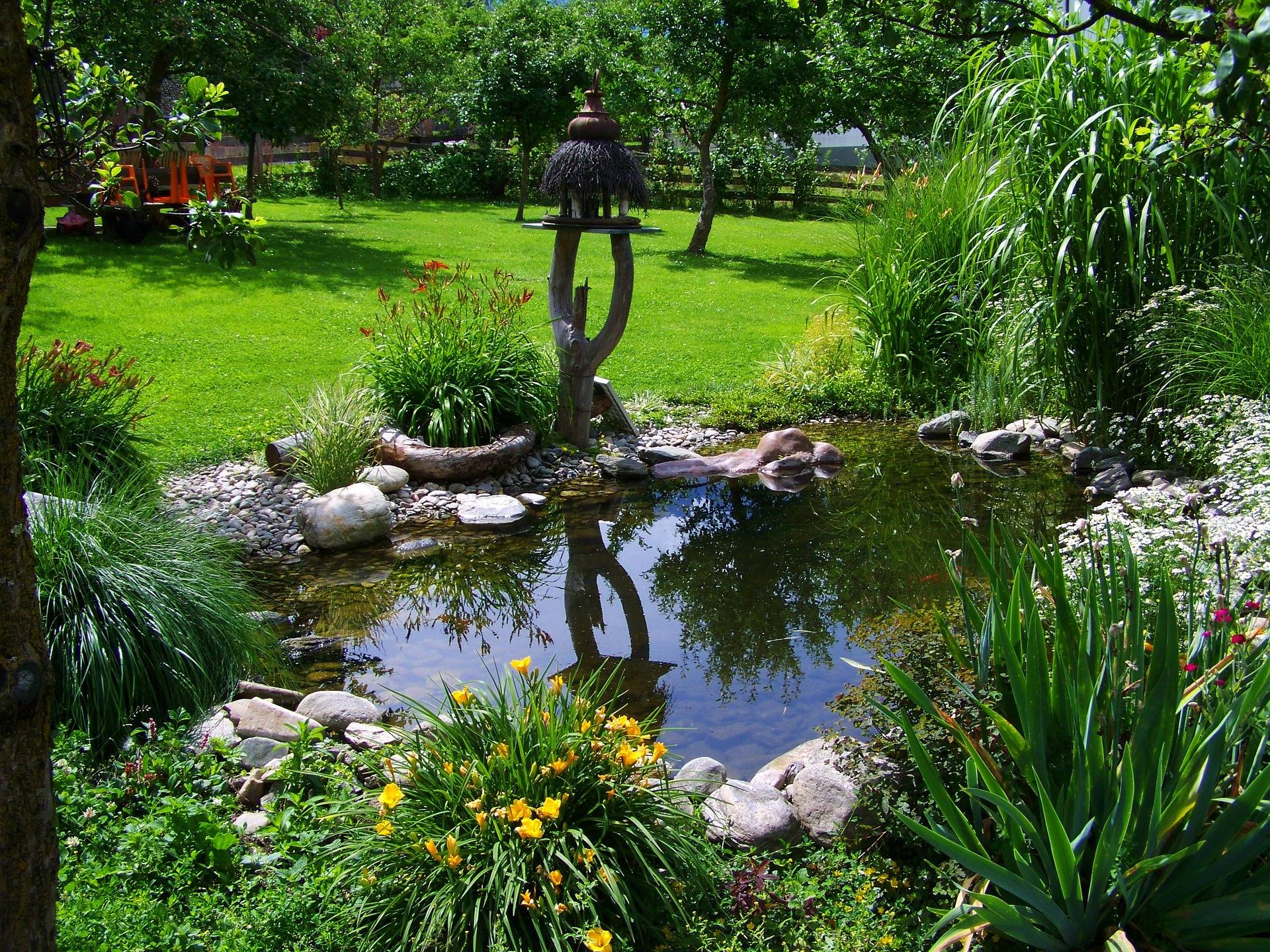Gardens are thing of beauty. Most of us desire to have an ornamental garden where we can enjoy a cup of tea or spend some time basking the sun or simply taking in some fresh air.
Though nature and its bloom always appeal to your senses, your enjoyment is magnified when your garden is designed aesthetically. Even if you have a kitchen garden along with your flower garden, a planned layout for your garden makes it aesthetically more appealing.
What you sow is what you reap! It’s true for your garden too. A clear conception of the garden design must be formulated when you start your gardening. Your garden may not always turn out as you planned, but you cannot expect great success when you don’t have a final goal.
A garden without a cohesive plan results in a confusion of ideas. When you want a garden that blooms year round, your design and choice of plants should match with the desired outcome.
So how do you design your home garden?

Don’t neglect the planning aspects of gardening. Take your journal and plan a design to match your flower and crops. Beginner gardeners often start planting flowers without a larger plan. Without a planned garden design, you have a chaos of colorful flowers and plants. Nature is inherently asymmetrical and prefers chaos. However, we humans have an affinity to organized environment.
You can achieve satisfaction and properly develop your outdoors only with a clear concept of what is to be done. A gardener must develop her plan at the very onset of work. One needs to study the outdoor space and how she could utilize the space to turn her ideas into bloom. One needs to choose the locations for various purposes of her gardening — landscaping, water bodies, creepers, ornamental areas, vegetable-garden, and fruit-bearing plants.
Without a well thought garden design, planting ideas and planning, you aren’t going to recreate beautiful gardens that we see in famed gardens. To make your outdoor space into a peaceful oasis of natural beauty, start with a good garden design and plan the space to match your home and personal preferences. Don’t just think of the open grounds in your yard. Include the patio, porch, balconies, and entrances within your garden design.
Sketch Your Garden Design
Take a journal or piece of paper. Draw your home boundaries (drawn to scale). Now, draw the main features of your outdoor space — the house, the walks and drives, the border planting, flower garden, kitchen garden, and fruit garden. You don’t have to stay 100% true to the design or don’t have to plan each detail at the very onset. However, you need to retain the design as a general guide.
Once you have demarcated your main sections for the outdoor space, start filling in with detailed designs. Mark what plants do you want and where. How do you want to develop your border flower beds? What shrubs do you want along the fence? If your paper isn’t big enough to fit the smallest of your garden design ideas, draw parts of your design on separate pages.
When you design your garden, don’t limit your planning to the structure. Gardens have flowers and plants that add a variety of colors. Select your plants to create the right semblance of a colorful design.
Garden Design as Picturesque Landscape
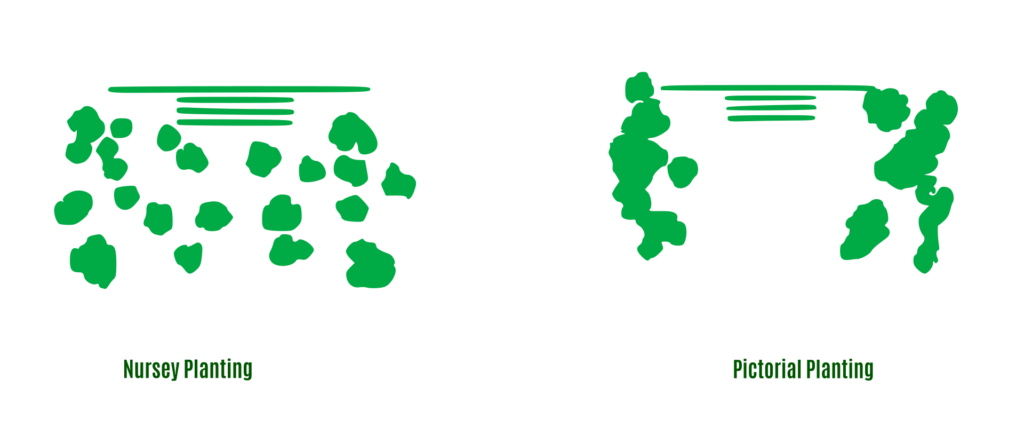
The picture in the landscape. The deficiency in most home grounds is not so much that there is too little planting of trees and shrubs as that this planting is meaningless. Every yard should be a picture. That is, the area should be set off from other areas, and it should have such a character that the observer catches its entire effect and purpose without stopping to analyze its parts. The yard should be one thing, one area, with every feature contributing its part to one strong and homogeneous effect. (Source: Manual of Gardening, L.H. Bailey)
Your garden design should look like a picture. Where bushes and trees are scattered over the area, the yard lacks a theme and appears chaotic. Your garden plants and bushes should unite together as a cohesive piece of work. Don’t treat your plants as individual entities. Instead each of your plants should have a place and purpose in the overall garden picture.
Lawn as the Canvas
In a garden design, you can treat your entire open space covered with lawn grass as the canvas. You start with this canvas of green grass and add different elements across it.
Most home garden designs have a central lawn around which plants and flowers are placed. Where the garden is broken into multiple parts, you will have more than one lawn.
Planting trees and flowers without a lawn results in a cluttered mass of vegetation. Such as layout is suited for nurseries and agriculture farms, but it doesn’t work well for home yards.
Like any good design, your garden needs open spaces too. Adding lot of elements in your canvas without breathing space is chaotic. For a garden, green lawns accord the breathing areas (akin to white space in graphic or web design).
Make the Garden Border
Clearly defined borders separate your garden from the rest of the surrounding. Without clear boundaries, your garden merges within the ambience. Unless your garden is designed to work with the outside spaces, you might end up with a chaotic look.
Native trees and shrubs serve as a great way to separate your open spaces from the rest of the world. It provide you with a contained space free from outside interference.
Even where the border plants don’t hide the outside world, it makes you keep that out when looking at the garden. Boundaries help you enjoy your garden space without being directly influenced by the outside spaces.
Border plants and shrubs serve the purpose of adding privacy to your house. It also provides nesting habitats for common bird species and creatures such as squirrels.
Flower Plants Add Colors
I do not mean to discourage the use of brilliant flowers and bright foliage and striking forms of vegetation; but these things are never primary considerations in a good domain. The structural elements of the place are designed first. The flanking and bordering masses are then planted. Finally the flowers and accessories are put in, as a house is painted after it is built. Flowers appear to best advantage when seen against a background of foliage, and they are then, also, an integral part of the picture. The flower-garden, as such, should be at the rear or side of a place, as all other personal appurtenances are; but flowers and bright leaves may be freely scattered along the borders and near the foliage masses.
It is a common saying that many persons have no love or appreciation of flowers, but it is probably nearer to the truth to say that no person is wholly lacking in this respect. Even those persons who declare that they care nothing for flowers are generally deceived by their dislike of flower-beds and the conventional methods of flower-growing. I know many persons who stoutly deny any liking for flowers, but who, nevertheless, are rejoiced with the blossoming of the orchards and the purpling of the clover fields. The fault may not lie so much with the persons themselves as with the methods of growing and displaying the flowers.
Birds, Bees & Butterflies
No garden is complete without chirping birds, buzzing bees and fluttering of butterflies.
Gardening design should also have provisions to attract and shelter creatures that make your garden lively. Bees and butterflies don’t just add life to your garden. These pollinators help in your garden growth and improve crop yields.
Birds come to live where they find suitable nesting places. When you add border plantings, it serves as a great habitat for sparrows and other species. Many birds that nest in cavities are attracted to bird houses. Bluebirds, house wrens, finches, swallows, woodpeckers, flycatchers, warblers, martins and many other birds can be attracted by bird houses where they can nest.
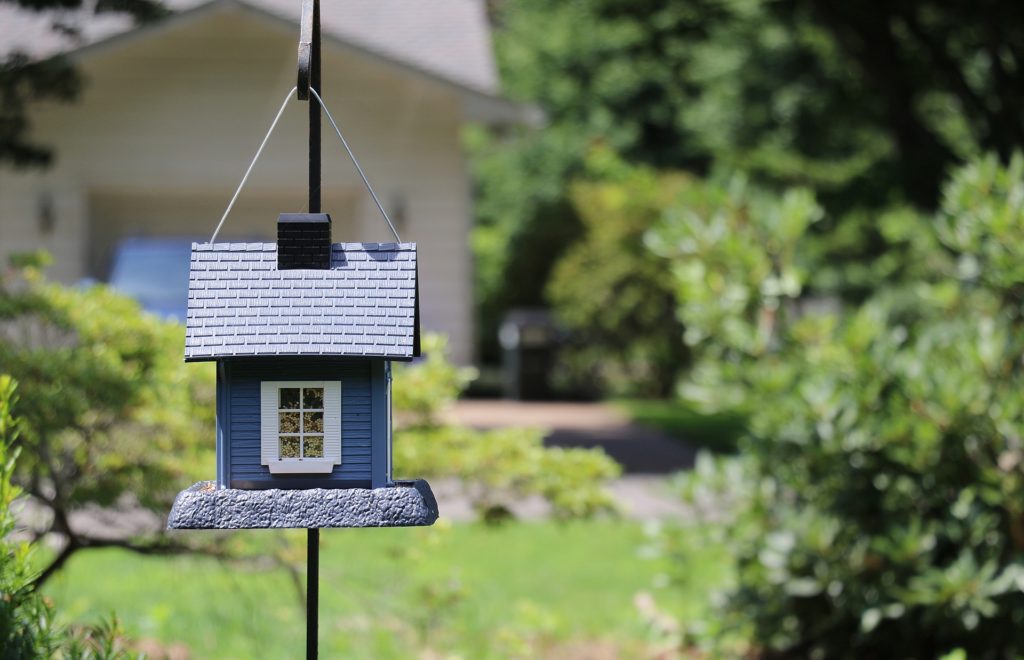
You can attract birds by providing a bird feeder with food and water. Adding bird fountains and bird baths also help you add an attractive feature in your garden. A slowly running or dripping fountain, with a good rim on which they may perch, will allow you to the birds while they drink or bathe. If you don’t want to buy a bird fountain, place fresh water in a shallow dish on the lawn. Place your water source away from your walk ways so as to provide your feathered guests privacy.
Select your bird houses based on the common bird species in your area. If you want small birds in your garden, you should place small bird houses that are best suited for nesting small birds. Pick a bird house with the right entrance hole size based on the birds you want to attract. A bird house with a large entrance hole will allow aggressive birds to squat. Similarly, your desired birds won’t be able to use the birdhouse if its entrance is too small.
Birds need privacy and safety for a comfortable habitat. Hang your bird houses firmly at a height safe from common predators such as cats, raccoons and snakes. Don’t place bird houses in places that you prefer. Birds don’t want to be under your constant gaze. As much as you want to enjoy watching birds, you need to locate the bird houses at places where they find comfort.
Ponds & Water Bodies in Garden
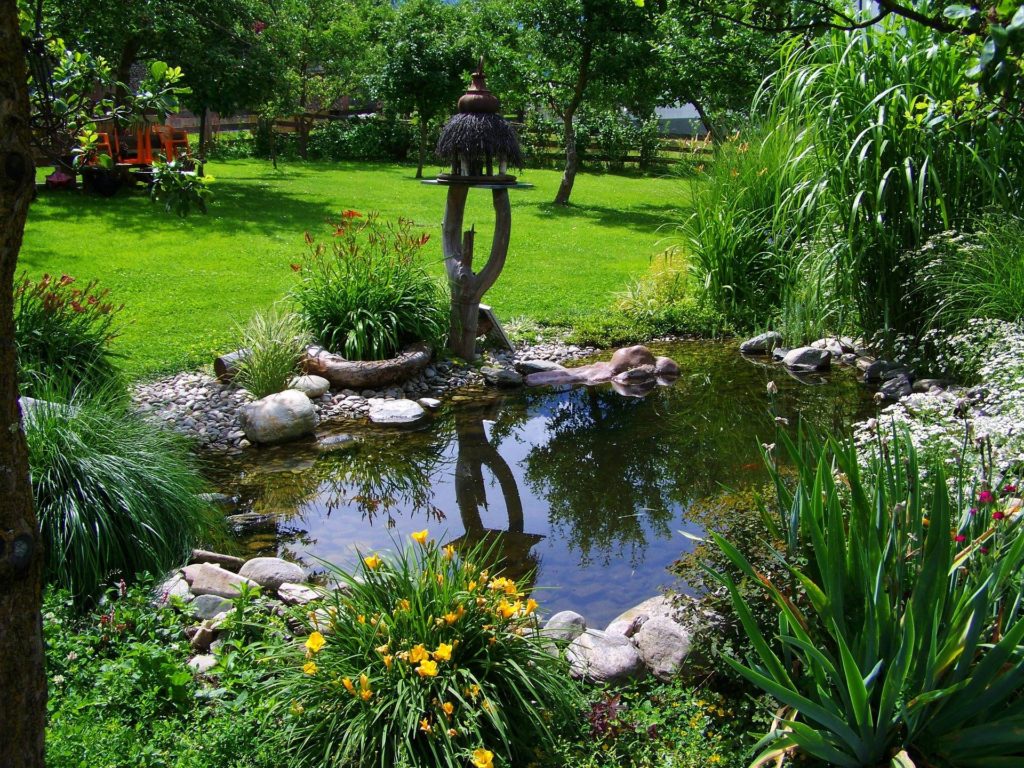
A garden design can be made more interesting with a pond or water body.
When designing a garden, you can incorporate a pond along with water-loving plants. Ideally, you should pick one side of your garden for placing a pond. Your pond should not be too close to the boundaries or walkways. Demarcate a wet zone and place your pond along with water-loving plants, such as cattails, willows, daylilies, and winterberry shrubs all around. Rocks, boulders, pathways, benches and chairs can be placed along with your pond design. Shrubs and plants can be used to create a landscaped fencing around the pond.
Ponds can also be used to grow aquatic plants such as creeping jenny, pickerel, taro, water lettuce, mosaic, sweet iris, sweet flag, Amazon frogbit, mosquito fern (Azolla), duckweed, water hyacinths, rough horsetail, umbrella palm, cattail and water lilies.
When your pond has plenty of thriving vegetation, you can also add fish to make it even more beautiful. An outdoor pond should have pH level around 7. Outdoor ponds need fish that can live in your environment. Placing aquarium fish in outdoor ponds doesn’t work as many of them need specific temperatures and water salinity. You need fish species that can adapt to natural pond water habitat. Some common outdoor pond fish include Algae Eater, Fathead Minnow, Goldfish, Golden Tench, Koi Carps, Rosette, Shubunkin, Sturgeon, Red Shiners, Golden Orfes and Sunfish.
Small Garden Pond: If you don’t have the space of time for a large pond, you can create a small garden pond. You can buy a small pond container (patio pond or container water garden) available in a variety of shapes and designs to create your water body. Small containers such as a whiskey barrel can be turned into a small outdoor pond. Line your barrel with pond liner and add a water pump for circulation. Put some auatic plants and small fish to enjoy your small garden pond.
Common Garden Designs
Let’s look at some common garden designs that you can use for your home garden.
Japanese Garden Design
A Japanese garden is designed with plants, water, and rocks. With an emphasis on nature, water serves as an important element in Japanese gardens — fish pond, waterfalls, bridges, pools and fountains. Rocks and pebbles are integrated in the design to resemble hillocks, riverbeds, etc. Natural materials such as bamboo and rocks is used to create most elements in Japanese gardens.
Japanese gardens usually rely of subtle differences in color and texture. Evergreen plants, grasses and mosses feature prominently. Bamboo poles are used for fencing and creating other structures. Living bamboo is often an important part of Japanese gardens.
Cottage Garden Design
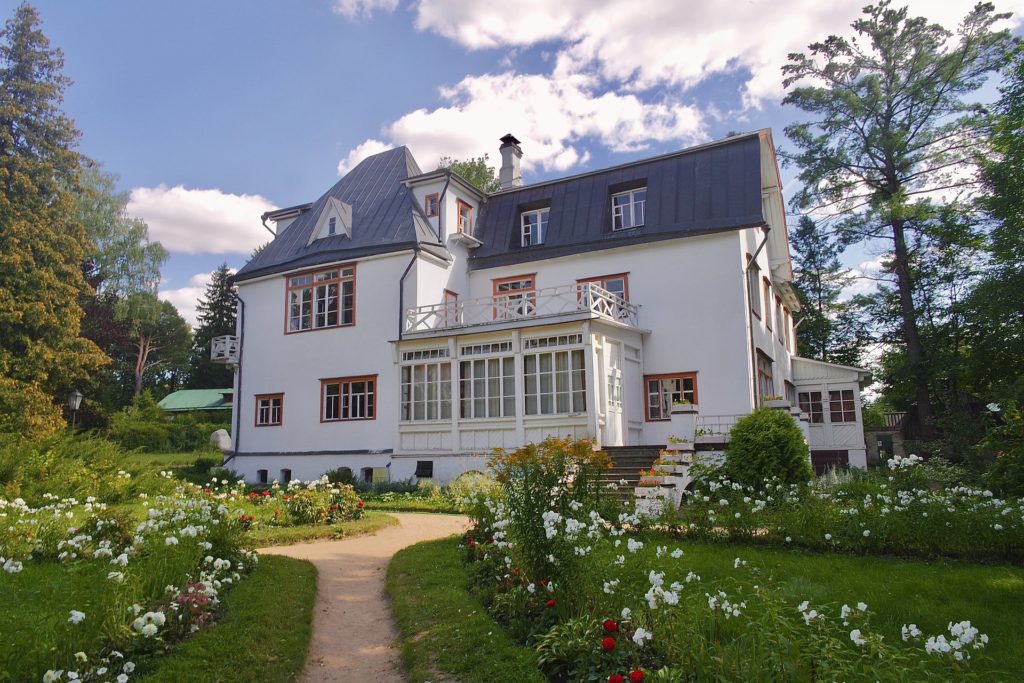
English cottage gardens appear carefree, but these too need careful planning and design. You need to select the plants carefully based on their heights and structure.
Tall plants need to be placed near walls or fences. Plants that are weak and need support should also be put around garden boundaries. A section of white picket fence can work as the perfect support and background for tall plants. A wooden fence also recreates the charm of a cottage.
Small plants need to be placed along walkways or near the edges for their unobstructed view. Sweet scented flowers should be planted near pathways, patio and proch where their fragrance can be easily enjoyed.
In cottage gardens, plants usually don’t follow straight lines or geometric designs. Generally, cottage gardens have chunks of flower plants intertwine with each other. Walkways are generally designed to be curving or winding. In cottage gardens, natural materials are used for creating paths and other elements to mimic a natural look. Arches with climbers and flowers can also be incorporated within a cottage garden design.
Desert Garden Design
Gardens have been maintained in the most arid of spaces. The fabled hanging gardens of Babylon were created within vast deserts. In the modern days, you can create and enjoy gardens in arid locations too.
Desert garden landscapes rely heavily on succulent plants and cacti. Stones are another important aspect of desert landscaping. Succulents are drought-tolerant plants that require very little water. Succulents can be found in all shapes and sizes.
Creeping sedums (stonecrops) are generally used as a ground cover replacing lawn grass. Stonecrops bloom in red, yellows and some other colors, providing an interesting resource for colorful patterns. Creeping sedums are versatile, and easy-to-grow perennials. Sedums easily cover ground with their fast growth.
Kalanchoe (Kalanchoe blossfeldiana) is a succulent houseplant that thrives both in containers and planted in ground. With a variety of colorful flowers in yellow, orange, red, pink, or white, these are perfect for adding a splash of color in desert gardens.
Kalanchoe plants are generally available for sale during late winter and spring. You can also plant these within your homes (in areas with sunlight) with very little maintenance. Kalanchoe has dark green, thick waxy leaves with scalloped-edges. Small, four-petaled flowers bloom in clusters above the foliage. Kalanchoe can brighten your indoors with flowers in shades of red, magenta, pink, orange, yellow and white.
Desert garden landscaping can be created with boulders, rocks, and stone. Several hardy varieties of tall grasses are also suited for desert conditions. You can also add water fountains and ponds in your desert garden landscape to attract birds and small mammals.

